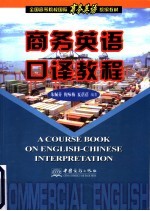

商务英语口译教程PDF电子书下载
- 电子书积分:12 积分如何计算积分?
- 作 者:朱佩芬,倪咏梅,夏蓓蓓编著
- 出 版 社:北京:中国商务出版社
- 出版年份:2004
- ISBN:7801812832
- 页数:333 页
第一章 口译理论概述(An Overview of Interpretation Theories) 1
第一节 历史沿革(The Evolution of Interpretation) 1
第二节 口译定义(The Definition of Interpretation) 2
目录 3
第三节 口译种类(The Categories of Interpretation) 3
第四节 口译过程(The Process of Interpretation) 4
第五节 口译特点(The Features of Interpretation) 5
第六节 口译标准(The Criteria of Interpretation) 8
第七节 译员素质(The Qualities of Interpreters) 9
第二章 即席翻译技巧(Consecutive Interpretation Skills) 13
第一节 听力理解技巧(Listening Comprehension Skills) 13
第二节 记忆技巧(Memory Skills) 15
一、以时间为线索(Using Time as Links) 15
二、以地点为线索(Using Places as Links) 16
三、以具体事由为线索(Using Causes as Links) 17
四、逻辑分析、归纳重点(Summarizing Key Pointsthrough Logical Analysis) 18
第三节 记录技巧(Note-taking Skills) 20
一、作记录的重要性(The Importance of Note-taking) 20
二、记录特点(The Characteristics of Note-taking) 21
三、记录格式(The Layout of Note-taking) 24
四、符号(Signs and Symbols) 27
五、缩略词(Abbreviations) 31
六、长词(Long Words) 31
七、数词(Numerals) 32
八、连词(Connectives) 38
九、记录练习(Note-taking Exercises) 38
(2)商务英语口译教程 41
第四节 表达技巧(Presentation Skills) 41
一、节奏与音色(Rhythm and Voice) 41
二、语音、语调与手势(Pronunciation,Intonation andGestures) 42
三、间歇与停顿(Pauses) 43
四、与听众保持目光接触(Eye Contact with the Audience) 44
第三章 即席翻译实践(Simulation Exercises and Explanations) 45
主题一 礼仪祝辞(Ceremonial Speeches) 45
主题二 商务谈判(Business Negotiations) 53
主题三 发展问题(Development Issues) 62
主题四 外交事务(Foreign Affairs) 69
主题五 经济贸易(Economy and Trade) 78
主题六 金融保险(Finance and Insurance) 88
主题七 环境保护(Environmental Protection) 96
主题八 基础建设(Infrastructure Construction) 105
主题九 教育文化(Education and Culture) 116
主题十 法律人权(Laws and Human Rights) 124
主题十一 企业管理(Business Administration) 135
主题十二 体育与健康(Sports and Health) 143
主题十三 科学技术(Science and Technology) 152
主题十四 旅游餐饮(Tourism and Catering) 162
主题十五 参观访问(Visits) 172
主题十六 世界贸易组织(The World Trade Organization) 180
主题十七 世博会(The World Expo) 189
主题十八 记者招待会(Press Conference) 199
第四章 同声传译及其他(Simultaneous Interpretation andMiscellaneous Issues) 212
第一节 为什么使用同声传译(Why Is Simultaneous Interpretation Needed) 212
二、灵活处理长句(Flexible Handling of Long Sentences) 213
第二节 同声传译技巧(Simultaneous Interpretation Skills) 213
一、合理分配注意力(Cultivating Split Attention) 213
三、掌握适当的间距(Keeping a Suitable Distance) 217
四、学会控制局面(Controlling the Situation) 218
五、注意讲话艺术(The Art of Making Speeches) 218
六、记录(Note-taking) 218
第三节 同声传译训练方法(Training Simultaneous Interpreters) 218
五、视译(Sight Interpretation) 219
四、目标语概述(Summarizing in Target Language) 219
六、同声传译(Simultaneous Interpretation) 219
二、干扰练习(Exercises with Interruptions) 219
三、源语概述(Summarizing in Source Language) 219
一、影子练习(Shadowing Exercises) 219
第四节 一些特殊情况的口译方法(Interpreting Sayings,Quotations and Jokes) 225
一、成语、谚语(Proverbs and Sayings) 225
二、典故(Literary Quotations) 226
三、笑话(Jokes) 227
第五节 其他注意事项(Miscellaneous) 227
一、不会译怎么办(What if I Can't Interpret) 227
二、错误的补救(What if I Made a Mistake) 228
三、保守机密(Keeping Secret) 229
四、注意礼节(Attending to Etiquette) 229
五、相互配合(Cooperation with Your Partner(s)) 230
练习参考答案(Key to the Exercises) 232
附录一 常用国际机构名称英汉对照表Appendix 1 Names of Major International Organizations 314
附录二 中国主要机构英汉对照表Appendix 2 Names of Major Chinese Organizations 321
附录三 常用国家(地区)名英汉对照表及记录方法Appendix 3 Names of Countries(Regions)and Their Abbreviations 324
附录四 常用缩略词英汉对照表 327
参考书目 332
- 《高级英语阅读与听说教程》刘秀梅编著 2019
- 《思维导图 超好用英语单词书》(中国)王若琳 2019
- 《看图自学吉他弹唱教程》陈飞编著 2019
- 《激光加工实训技能指导理实一体化教程 下》王秀军,徐永红主编;刘波,刘克生副主编 2017
- 《AutoCAD 2019 循序渐进教程》雷焕平,吴昌松,陈兴奎主编 2019
- 《少儿电子琴入门教程 双色图解版》灌木文化 2019
- 《初中生英语作文 提高篇》清瑶主编 2019
- 《培生高级英语语法 练习册》培生教育 2019
- 《指向核心素养 北京十一学校名师教学设计 英语 七年级 上 配人教版》周志英总主编 2019
- 《Photoshop CC 2018基础教程》温培利,付华编著 2019
- 《市政工程基础》杨岚编著 2009
- 《家畜百宝 猪、牛、羊、鸡的综合利用》山西省商业厅组织技术处编著 1959
- 《《道德经》200句》崇贤书院编著 2018
- 《高级英语阅读与听说教程》刘秀梅编著 2019
- 《计算机网络与通信基础》谢雨飞,田启川编著 2019
- 《看图自学吉他弹唱教程》陈飞编著 2019
- 《法语词汇认知联想记忆法》刘莲编著 2020
- 《培智学校义务教育实验教科书教师教学用书 生活适应 二年级 上》人民教育出版社,课程教材研究所,特殊教育课程教材研究中心编著 2019
- 《国家社科基金项目申报规范 技巧与案例 第3版 2020》文传浩,夏宇编著 2019
- 《流体力学》张扬军,彭杰,诸葛伟林编著 2019
- 《中国当代乡土小说文库 本乡本土》(中国)刘玉堂 2019
- 《异质性条件下技术创新最优市场结构研究 以中国高技术产业为例》千慧雄 2019
- 《中国铁路人 第三届现实主义网络文学征文大赛一等奖》恒传录著 2019
- 《莼江曲谱 2 中国昆曲博物馆藏稀见昆剧手抄曲谱汇编之一》郭腊梅主编;孙伊婷副主编;孙文明,孙伊婷编委;中国昆曲博物馆编 2018
- 《中国制造业绿色供应链发展研究报告》中国电子信息产业发展研究院 2019
- 《中国陈设艺术史》赵囡囡著 2019
- 《指向核心素养 北京十一学校名师教学设计 英语 七年级 上 配人教版》周志英总主编 2019
- 《《走近科学》精选丛书 中国UFO悬案调查》郭之文 2019
- 《清至民国中国西北戏剧经典唱段汇辑 第8卷》孔令纪 2018
- 《北京生态环境保护》《北京环境保护丛书》编委会编著 2018
